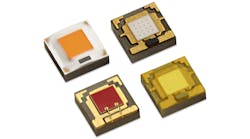The "Glowing Places" project, which make its US debut at the Film Festival in Park City, Utah this week, was chosen from about 10 concepts. It consists of transparent seating units, embedded with LED strips and sensors, measuring the presence of people over time.
Both the number of people sitting and the length of time they stay create a "social interactive pattern" that is translated by patented software into lighting effects in the furniture, as well as lighting patterns that can be projected onto a building facade.
Thus, many people sitting for brief periods of time could result in lighting that expresses busy activity, whereas one or two people sitting for a longer period would trigger mellow lighting.
LEDs play a big role in the success of the Glowing Places project. "LEDs give more design freedom, and can be embedded into building materials or furniture without ever requiring replacement," says Jos Stuyfzand, Lighting Design Director at Philips Design. "They can also direct light more accurately and be computer-controlled for dynamic lighting solutions."
Philips Design claims that the use of artificial light to create atmosphere promises to change the way we use lighting forever. New lighting technologies integrated into the structure of the objects and buildings around us will respond to our needs with a breathtaking array of colors and intensities, enhancing whatever we're doing.
"If you're having a good time with friends at home it would be very nice if the lighting adapted to suit your behavior without you having to do anything," says Job Rutgers, Senior Design Consultant at Philips Design. Glowing Places aims to do this for large public spaces.
Dynamic lighting systems make public places - waiting rooms for example - more pleasant, because in contrast to static artificial lighting the Glowing Places concept emulates aspects of changing natural light. As well as being a social catalyst, the illuminated chairs create a valuable personal space, giving a feeling of rest, tranquility and personal connectivity.
Applications for the Glowing Places concept include public spaces such as shopping malls, subway stations and other static artificially-lit indoor spaces where people gather.







